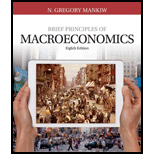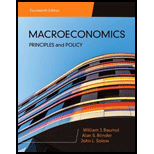
Subpart (a):
Equations describing the economy.
Subpart (a):
Explanation of Solution
Concept introduction:
Consumption spending: Consumption spending refers to the amount of expenditure incurred for consuming goods and services at a particular tie period with the given level of income.
Investment: An investment is the money invested in terms of assets and buildings by the individual, for future consumption and profit making.
GDP (Gross domestic product): GDP refers to the market value of all final goods and services produced in an economy during an accounting year.
Multiplier: Multiplier refers to the ratio of change in the real GDP to the change in initial consumption at a constant price rate. A multiplier is positively related to the marginal propensity to consume and negatively related with the marginal propensity to save.
Marginal propensity to consume (MPC): Marginal propensity to consume refers to the sensitivity of change in the consumption level, due to the changes that have occurred in the income level.
Subpart (b):
Equations describing the economy.
Subpart (b):
Explanation of Solution
The slope of the consumption function is the marginal propensity to consume (MPC). Since the consumption function is
Concept introduction:
Consumption spending: Consumption spending refers to the amount of expenditure incurred for consuming goods and services at a particular tie period with the given level of income.
Investment: An investment is the money invested in terms of assets and buildings by the individual, for future consumption and profit making.
GDP (Gross domestic product): GDP refers to the market value of all final goods and services produced in an economy during an accounting year.
Multiplier: Multiplier refers to the ratio of change in the real GDP to the change in initial consumption at a constant price rate. A multiplier is positively related to the marginal propensity to consume and negatively related with the marginal propensity to save.
Marginal propensity to consume (MPC): Marginal propensity to consume refers to the sensitivity of change in the consumption level, due to the changes that have occurred in the income level.
Subpart (c):
Equations describing the economy.
Subpart (c):
Explanation of Solution
Since the interest rate r is 4 percent, the GDP can be equated as follows:
The GDP is 1800. The calculated GDP
Concept introduction:
Consumption spending: Consumption spending refers to the amount of expenditure incurred for consuming goods and services at a particular tie period with the given level of income.
Investment: An investment is the money invested in terms of assets and buildings by the individual, for future consumption and profit making.
GDP (Gross domestic product): GDP refers to the market value of all final goods and services produced in an economy during an accounting year.
Multiplier: Multiplier refers to the ratio of change in the real GDP to the change in initial consumption at a constant price rate. A multiplier is positively related to the marginal propensity to consume and negatively related with the marginal propensity to save.
Marginal propensity to consume (MPC): Marginal propensity to consume refers to the sensitivity of change in the consumption level, due to the changes that have occurred in the income level.
Subpart (d):
Equations describing the economy.
Subpart (d):
Explanation of Solution
Assuming no change in
Since the MPC is 0.75, the multiplier can be calculated thus
The multiplier is 4. Thus, to increase GDP by 200
Concept introduction:
Consumption spending: Consumption spending refers to the amount of expenditure incurred for consuming goods and services at a particular tie period with the given level of income.
Investment: An investment is the money invested in terms of assets and buildings by the individual, for future consumption and profit making.
GDP (Gross domestic product): GDP refers to the market value of all final goods and services produced in an economy during an accounting year.
Multiplier: Multiplier refers to the ratio of change in the real GDP to the change in initial consumption at a constant price rate. A multiplier is positively related to the marginal propensity to consume and negatively related with the marginal propensity to save.
Marginal propensity to consume (MPC): Marginal propensity to consume refers to the sensitivity of change in the consumption level, due to the changes that have occurred in the income level.
Subpart (e):
Equations describing the economy.
Subpart (e):
Explanation of Solution
Assuming no change in fiscal policy, a decrease in interest rate would restore full employment. The amount at which the interest rate needs to be decreased can be calculated as follows:
The interest rate needs to be 3 percent for full employment. Thus, a decrease of 1 percent
Concept introduction:
Consumption spending: Consumption spending refers to the amount of expenditure incurred for consuming goods and services at a particular tie period with the given level of income.
Investment: An investment is the money invested in terms of assets and buildings by the individual, for future consumption and profit making.
GDP (Gross domestic product): GDP refers to the market value of all final goods and services produced in an economy during an accounting year.
Multiplier: Multiplier refers to the ratio of change in the real GDP to the change in initial consumption at a constant price rate. A multiplier is positively related to the marginal propensity to consume and negatively related with the marginal propensity to save.
Marginal propensity to consume (MPC): Marginal propensity to consume refers to the sensitivity of change in the consumption level, due to the changes that have occurred in the income level.
Want to see more full solutions like this?
Chapter 16 Solutions
Brief Principles of Macroeconomics (MindTap Course List)
- The Firm's Output Decision (Study Plan 12.2) Use the following table to work Problems 4 to 6. Pat's Pizza Kitchen is a price taker. Its costs are Output (pizzas per hour) Total cost (dollars per hour) 0 10 1 21 2 30 3 41 4 54 5 69 4. Calculate Pat's profit-maximizing output and economic profit if the market price is (i) $14 a pizza. (ii) $12 a pizza. (iii) $10 a pizza. 5. What is Pat's shutdown point and what is Pat's economic profit if it shuts down temporarily? 6. Derive Pat's supply curve.arrow_forwardUse the following table to work Problems 27 and 28. ProPainters hires students at $250 a week to paint houses. It leases equipment at $500 a week. The table sets out its total product schedule. Labor (students) 1 Output (houses painted per week) 2 23 5 3 9 4 12 5 14 6 15 27. If ProPainters paints 12 houses a week, calculate its total cost, average total cost, and marginal cost. At what output is average total cost a minimum? 28. Explain why the gap between ProPainters' total cost and total variable cost is the same no matter how many houses are painted.arrow_forwardUse the following table to work Problems 17 to 20. The table shows the production function of Jackie's Canoe Rides. Labor Output (rides per day) (workers per day) Plant 1 Plant 2 Plant 3 Plant 4 10 20 40 55 65 20 40 60 75 85 30 65 75 90 100 40 75 85 100 110 Canoes 10 20 30 40 Jackie's pays $100 a day for each canoe it rents and $50 a day for each canoe operator it hires. 19. a. On Jackie's LRAC curve, what is the average cost of producing 40, 75, and 85 rides a week? b. What is Jackie's minimum efficient scale?arrow_forward
- Not use ai pleasearrow_forward1. Riaz has a limited income and consumes only Apple and Bread. His current consumption choice is 3 apples and 5 bread. The price of apple is $3 each, and the price of bread is $2.5 each. The last apple added 5 units to Sadid's utility, while the last bread added 7 units. Is Riaz making the utility-maximizing choice? Why or why not? Do you suggest any adjustment in Riaz's consumption bundle? Why or why not? Give reasons in support of your answer. State the condition for a consumer's utility maximizing choice and illustrate graphically. 2. Consider the following table of long-run total costs for three different firms: Quantity Total Cost ($) Firm A Firm B Firm C 1 60 11 21 2 70 24 34 3 80 39 49 4 90 56 66 5 100 75 85 6 110 96 106 7 120 119 129 Does each of these firms experience economies of scale or diseconomies of scale? Explain your answer with necessary calculations.arrow_forwardRiaz has a limited income and consumes only Apple and Bread. His current consumption choice is 3 apples and 5 bread. The price of apple is $3 each, and the price of bread is $2.5 each. The last apple added 5 units to Sadid's utility, while the last bread added 7 units. Is Riaz making the utility-maximizing choice? Why or why not? Do you suggest any adjustment in Riaz's consumption bundle? Why or why not? Give reasons in support of your answer.State the condition for a consumer's utility maximizing choice and illustrate graphically.arrow_forward
- 1. Riaz has a limited income and consumes only Apple and Bread. His current consumption choice is 3 apples and 5 bread. The price of apple is $3 each, and the price of bread is $2.5 each. The last apple added 5 units to Sadid's utility, while the last bread added 7 units. Is Riaz making the utility-maximizing choice? Why or why not? Do you suggest any adjustment in Riaz's consumption bundle? Why or why not? Give reasons in support of your answer. State the condition for a consumer's utility maximizing choice and illustrate graphically.arrow_forward1. Riaz has a limited income and consumes only Apple and Bread. His current consumption choice is 3 apples and 5 bread. The price of apple is $3 each, and the price of bread is $2.5 each. The last apple added 5 units to Sadid's utility, while the last bread added 7 units. Is Riaz making the utility-maximizing choice? Why or why not? Do you suggest any adjustment in Riaz's consumption bundle? Why or why not? Give reasons in support of your answer. State the condition for a consumer's utility maximizing choice and illustrate graphically.arrow_forward2. Consider the following table of long-run total costs for three different firms: Quantity Total Cost ($) Firm A Firm B Firm C 1 60 11 21 2 70 24 34 3 80 39 49 4 90 56 66 5 100 75 85 6 110 96 106 7 120 119 129 Does each of these firms experience economies of scale or diseconomies of scale? Explain your answer with necessary calculations.arrow_forward

 Economics (MindTap Course List)EconomicsISBN:9781337617383Author:Roger A. ArnoldPublisher:Cengage Learning
Economics (MindTap Course List)EconomicsISBN:9781337617383Author:Roger A. ArnoldPublisher:Cengage Learning




